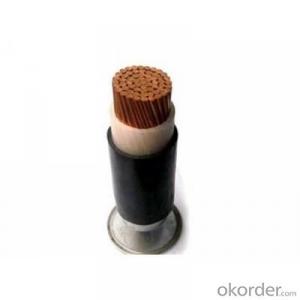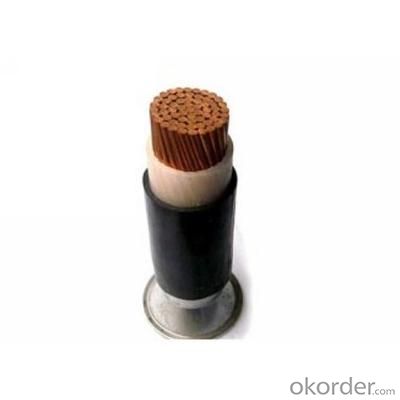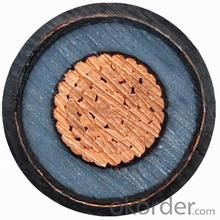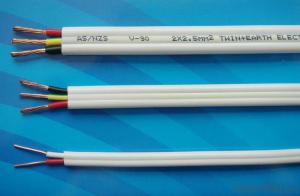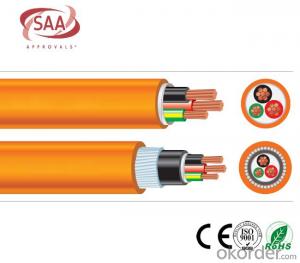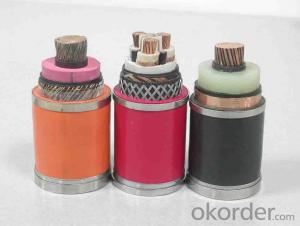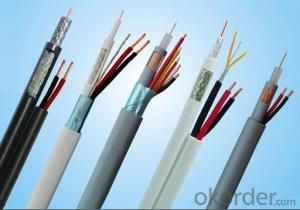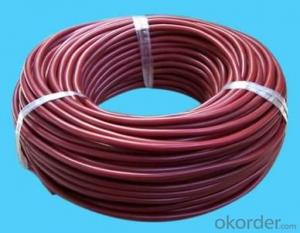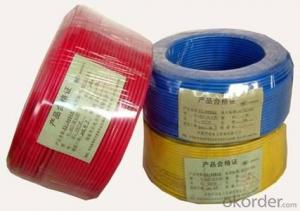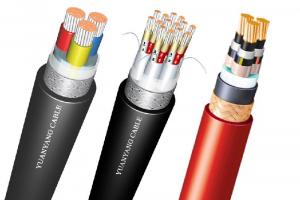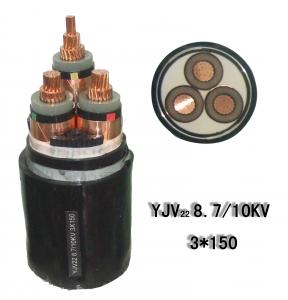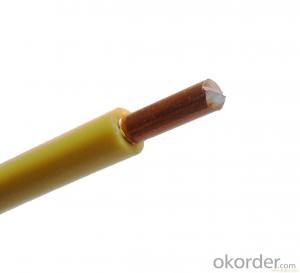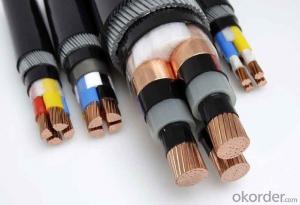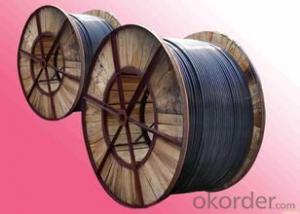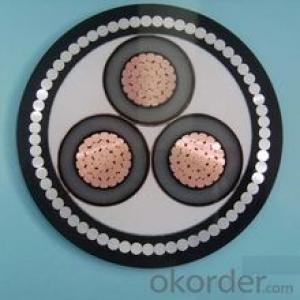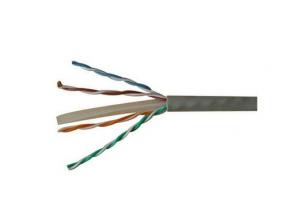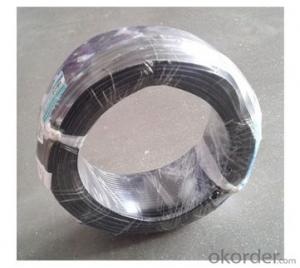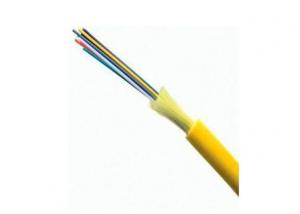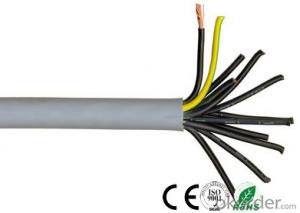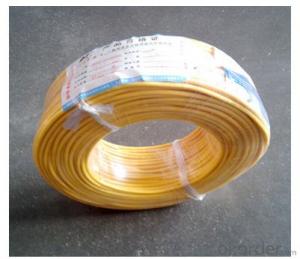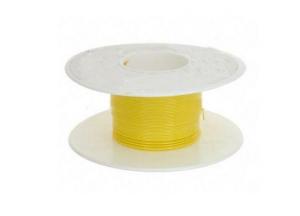CU/PVC/SWA/PVC Single core Electric Cable 0.6/1kV
- Loading Port:
- China main port
- Payment Terms:
- TT OR LC
- Min Order Qty:
- 500 m
- Supply Capability:
- 50000 m/month
OKorder Service Pledge
OKorder Financial Service
You Might Also Like
CU/PVC/SWA/PVC Single core Electric Cable 0.6/1kV
Rated Voltage 6kV and 30kV power cable (XLPE insulated),6kV-30kV
Cross-sectional area : single core,three-core 25-630mm2
Copper ,aluminum conductor, metal tape armoured,wire armoured.
Rated Voltage 30kV power cable (XLPE insulated), 21/35kV,26/35kV,
Cross-sectional area : single core,three-core 25-630mm2
Power cable Structure
The basic structure of power cables by the core (conductor), an insulating layer, a shielding layer and a protective layer of four parts.
1. The core is conductive part of power cable, which is used to transfer power, is the main part of the power cable.
2. Insulation is the line between the core and the earth and the different phase of wire core in the electrical insulated from each other, is an indispensable part in the structure of power cable.
3. Shield 10KV power cable shielding layer and more generally have a conductor shielding layer and an insulating shielding layer.
4. Protective layer The role of the protective layer is to protect the power cable from the outside world the invasion of the impurities and moisture, and prevent the external force directly damage the power cable.
Specifications:
Type | Core | Rated voltage(kV) | ||||||||
Copper | Aluminum | 0.6/1 | 3.6/6 | 6/6 | 8.7/10 | 12/20 | 18/20 | 21/35 | 26/35 | |
YJV | YJLV | 1 | 1.5~400 | 25~500 | 25~500 | 25~500 | 35~500 | 50~500 | 50~500 | 50~500 |
3 | 1.5~300 | 25~300 | 25~300 | 25~300 | 35~300 | 50~300 | 50~300 | 50~300 | ||
2 | 1.5~150 | - | - | - | - | - | - | - | ||
3+1 | 4~400 | - | - | - | - | - | - | - | ||
3+2,4+1 | 50~240 | - | - | - | - | - | - | - | ||
5 | 1.5~35 | - | - | - | - | - | - | - | ||
YJV22 | YJLV22 | 1 | 4~400 | 25~500 | 25~500 | 25~500 | 35~500 | 50~500 | 50~500 | 50~500 |
3 | 2.5~300 | 25~300 | 25~300 | 25~300 | 35~300 | 50~300 | 50~300 | 50~300 | ||
2 | 4~150 | - | - | - | - | - | - | - | ||
3+1 | 4~300 | - | - | - | - | - | - | - | ||
3+2,4+1 | 50~240 | - | - | - | - | - | - | - | ||
5 | 2.5~35 | - | - | - | - | - | - | - | ||
Note: We can produce steel-armored wire according to user needs, such as: YJV32, YJLV32 type; the flame retardant cable should plus “ZR” in front of the original model when ordering.
Hot spot! Factory High quality Low voltage electric power cable
Certificates
CE, RoHS, CCC, KEMA and more others at request
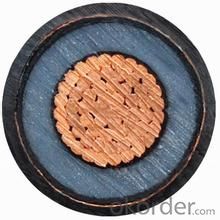
- Q: i would like to know exactly where i can disconnect my wire feed that goes into my door. Theres a couple places i think maybe it comes undone, but i dont want to force anything and break a connector. i need to take off my door.
- You need to pop off your door panel by taking out all the screws first then un- hook the snap rivots all around the edge of the door and slide it over the door handle but youll have to unplug the speaker and window switch first. After its off all you need to do is follow the wiring that goes thru the grommet in the crotch of the door where it closes near the fender and there is alot of wires so make sure you take your time and dont snap off the harness hooks because they brake easily. You'll have some that go to your speaker and some to the main door window/locks/mirrors all those. If you look at that grommet previously mentioned pull it out and you can slide all the wires thru that open hole and your done. Alot of this stuff is taped or screwed on so take your time if it doesnt go on the first pull then look at whats holding you. Hope this is what you needed and if you need more ill be happy to accept an email on this situation
- Q: All the DIY info shows how to change a light fixture. What do you do with the wiring if you want to remove a chandelier, but not replace it with another?I want to make sure the wires in the ceiling are not capable of starting a fire. This is in the first floor of a two-story.
- With respect to the wiring instead of connecting wires to a new fixture they need to be capped with wire nuts instead. With respect to the empty area there are two approaches. If the box is neatly recessed in the ceiling then a larger decorative cover plate will do the job nicely. You do not want to use an electrical cover plate for the normal round box as it will leave unsealed edges around it. If the wires are long and the box is short you might adapt to a wiremold box that will include an adapting plate and the external round box that will project an inch down from the ceiling. Then you will need to add the decorative (wide) blank cover plate. Since you are asking this question there is also an obvious suggestion that you might have someone who is familiar with electrical wiring to do this as someone new to wiring might easily overlook something that a more experienced eye will catch.
- Q: First off, I apologize for my ignorance; I'm new at this. Does electrical wire (12 gauge for example), come as a single wire? For example, if I'm installing a 20A outlet 40 feet away from the breaker, do I need 40 or 80 feet of 12 gauge wire?It is my understanding that each outlet needs a (+) and (-) wire, as well as a grounding wire. Is this correct?Thanks for your help!
- You would need over 80 feet of wire. In fact you would need over 120 feet of wire. Bends and non-direct routing will take up some of the distance. You need three conductors: one hot (usually black, blue or red in the US), one neutral (white in the US) and a ground (either green or bare). Individual wires MUST be run in conduit, but if the entire run is in a sheltered area you may be able to use nonmetallic cable, for instance Romex. This is the white or yellow flattish cable you see that has two wires inside it plus a grounding conductor. In such instances the ground is usually bare. Under certain conditions you can also use flexible armored cable (looks a bit like a flex lamp neck). I'm not wild about the stuff but it has its uses. You sound pretty new to the whole electrical trade and I strongly advise you to proceed cautiously after reading up on the subject. If in doubt, call a pro. It won't be cheap, but it's cheaper than rebuilding your house after it burns down, or paying funeral costs.
- Q: i have a problem where my acc fuse keeps blowing and im tired of replacing fuses so what i was wondering is if it was safe to straight wire an interior light with an inline fuse and a toggle switch and would it cause any kinds of conflict
- It will not be a problem just make sure the wire doesn't touch ground(metal) anywhere and also keep a check on it for ware. If the wire touches metal after the inline fuse it will blow it. If it grounds before the fuse then it could cause a fire. So protect it well and it should be fine.
- Q: cf ceiling fanlf old light fixtureI took down the old light fixture and there are 4 wires total; 2 white wires. Then there is 2 black taped off wires. The 2 white wires were the only wires connected, separately to the old light fixture. I tested all of the wires and all are hot except 1 white wire. I assumed that was ground. I installed my ceiling fan as follows; cf white wire to lf white wire. cf ground wire to non-hot lf white wire. cf black and black/white wire to only 1 lf black wire. I taped off the other hot black wire because i didn't think i needed to connect it. Turned light switch on, nothing. Fan does not work, light in fan does not work. Did I connect the wires incorrectly----- HELP! Thanks!
- You didn't say if you had a wall switch. This matters. Generally, both white wires are spliced together and these are the neutral. The 2 black wires are both hot. The ground wires are green or bare copper. You should have 2 black wires coming out of the light/fan; these are hot and are spliced to 2 hot wires from the ceiling fixture. Always black to black and cap these off. You hooked up the white neutral wire to the ground wire which is incorrect. If you don't have a ground wire coming out from the ceiling fixture which would be green or bare copper, just hook the ground wire from the light/fan to the metal plate in the ceiling. Good Luck!
- Q: I have an old farm house with 3 out buildings. The main house has electrical service. One out building has a circuit panel that then feeds to an out building and a barn. The out building with a circuit panel used to have separate electrical service but does not any longer. I would like to run a feeder line from the main house to the outbuilding circuit panel which would then provide power to the barn and additional out building. the distance between the two circuit panels is approximately 120'. there is a standard indoor line that runs most of the way. Can these two boxes be tied together at all? With the standard 12/2 line that is in place? What I would be running off this line is basically lights in the barn and 2-3 computers plus a space heater in the outbuilding.Any ideas?
- There are no code limits on general use receptacles on a circuit, however, you want to try to anticipate potential heavy loads that may be on that circuit all at one time. If you're turning them into bedrooms, you can generally put two bedrooms on a 15amp circuit because the biggest load you'll ever plug in is a vacuum cleaner. If you're only doing two rooms, you'll want at least two circuits just for good measure, not necessarily a code requirement. If window AC units are anticipated (unlikely in a basement, I know) then you'll want a 20amp dedicated circuit for each AC unit. Window ACs draw a lot of amps, and if you have a dedicated circuit for each window AC you could turn that run into a 240v circuit should you purchase a 240v AC. If you're just putting in one ceiling fixture in each room, then the lighting can be on the receptacle circuits. However, if you were going to be putting a whole bunch of recessed fixture (I would if it were me) you can only load a circuit up to 80% because lighting fixtures are considered constant use. So if you figure out the amps that your fixture will draw (figure with the largest wattage bulb installed in the fixture, even if you're not going to use the max wattage bulb) you can only put 12 amps on a 15amp breaker and 16 amps on a 20 amp breaker. Also, for general use receptacles and general lighting we normally run 14 gauge wire since it's easier to pull and work with. 12 gauge is generally for where you know you'll have a heavy load. These days with computers, LED tvs, and cfl and led lighting, peoples homes are drawing less and less energy, in general. You definitely should consider a dedicated 20amp circuit for if you're going to be using space heaters, sump pumps, dehumidifiers, etc.
- Q: I just bought a house, and the area where the dryer needs to go only has a two foot electrical wire coming out of the wall. It's an old house, and it's possible these people just hooked those wires directly to the dryer without using an outlet. Is that possible? Or do I need to install those wires into a three prong outlet for electrical supply to my dryer?Thanks!
- Yes, it's possible to wire some dryers w/o a plug. However, it's not commonly done in residential settings as most people don't have an electrician around to disconnect it if it needs service or to be moved for some reason.
- Q: I built a 30x30 workshop and have a few electrical questions.What amp size service panel will I need?Will have 8 120v receptacles and do they all need separate 20 amp breakers with #12 wire?Will have 2 240v receptacles, air compressor and a stick welder, what size wire and circuit breakers for those two components?Will have 8 fluorescent lights with 54w bulbs, How many lights can be on the same 15amp circuit with #14 wire?
- I would put the fluorescent lamps on two separate circuits. The reason is that you will still have lighting if you have to do maintenance on one of the fixtures. I would also put the 8 120vac outlets on two separate circuits. Your air compressor should be on a 40 amp circuit. Your welder is on a 100 amp circuit from a sub-panel. It's highly unlikely you'll use the compressor at the same time you would be using the air compressor. Both are intermittent duty. From your limited info, I would go for a 150 amp service.
- Q: I am looking for a Wiring Diagram for a 2006 Tiburon SE. Just this morning a list of thing weren't working in my car: Power Window, Power Locks, Turn Signals, Hazards, Fog Lights, no automatic windshield wiper swipe after using the wiper fluid, glovebox light. Everything else appears to be working. Any other insight would be extremely helpful. Thank you.
- Try the fuse box, not the little one in the car the one under the hood.
- Q: i need to run an eletrical wire from one building to another. both have breaker boxes the first is a 200 amp which will feed a 100amp
- If you are underground, the wire needs to be at least 36 deep and covered with a warning tape, and fine sand or topsoil, unless you are in rigid steel conduit. If the wire is going to be in conduit, it still needs to be inspected by the AHJ before you pull the wire and after the whole job is finished. Also you need to buy the proper permits and or you jeopardize the resale value of the property if it is not properly inspected. To pull the wire through the conduit will take at least 2 people, you also need to have the correct type of circuit breaker. It is so much easier, faster and in the long run cheaper to have a qualified professional electrician do the work.
Send your message to us
CU/PVC/SWA/PVC Single core Electric Cable 0.6/1kV
- Loading Port:
- China main port
- Payment Terms:
- TT OR LC
- Min Order Qty:
- 500 m
- Supply Capability:
- 50000 m/month
OKorder Service Pledge
OKorder Financial Service
Similar products
Hot products
Hot Searches
Related keywords
